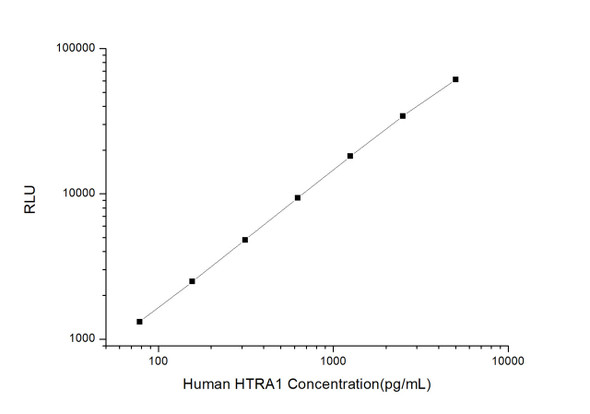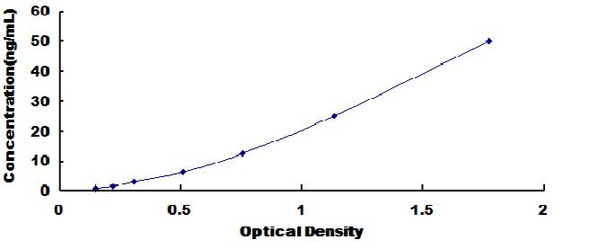Human Cell Biology ELISA Kits 6
Human HTRA1 (HtrA Serine Peptidase 1) ELISA Kit (HUES01636)
- SKU:
- HUES01636
- Product Type:
- ELISA Kit
- Size:
- 96 Assays
- Uniprot:
- Q92743
- Sensitivity:
- 0.19ng/mL
- Range:
- 0.31-20ng/mL
- ELISA Type:
- Sandwich
- Synonyms:
- ARMD7, CARASIL, HtrA, L56, ORF480, PRSS11
- Reactivity:
- Human
- Sample Type:
- Serum, plasma and other biological fluids
- Research Area:
- Cell Biology
Description
| Assay type: | Sandwich |
| Format: | 96T |
| Assay time: | 4.5h |
| Reactivity: | Human |
| Detection Method: | Colormetric |
| Detection Range: | 0.31-20 ng/mL |
| Sensitivity: | 0.19 ng/mL |
| Sample Volume Required Per Well: | 100µL |
| Sample Type: | Serum, plasma and other biological fluids |
| Specificity: | This kit recognizes Human HTRA1 in samples. No significant cross-reactivity or interference between Human HTRA1 and analogues was observed. |
This ELISA kit uses Sandwich-ELISA as the method. The micro ELISA plate provided in this kit has been pre-coated with an antibody specific to Human HTRA1. Standards or samples are added to the appropriate micro ELISA plate wells and combined with the specific antibody. Then a biotinylated detection antibody specific for Human HTRA1 and Avidin-Horseradish Peroxidase (HRP) conjugate are added to each micro plate well successively and incubated. Free components are washed away. The substrate solution is added to each well. Only those wells that contain Human HTRA1, biotinylated detection antibody and Avidin-HRP conjugate will appear blue in color. The enzyme-substrate reaction is terminated by adding Stop Solution and the color turns yellow. The optical density (OD) is measured spectrophotometrically at a wavelength of 450 nm ± 2 nm. The OD value is proportional to the concentration of Human HTRA1. The concentration of Human HTRA1 in samples can be calculated by comparing the OD of the samples to the standard curve.
| UniProt Protein Function: | HTRA1: Serine protease with a variety of targets, including extracellular matrix proteins such as fibronectin. HTRA1-generated fibronectin fragments further induce synovial cells to up-regulate MMP1 and MMP3 production. May also degrade proteoglycans, such as aggrecan, decorin and fibromodulin. Through cleavage of proteoglycans, may release soluble FGF-glycosaminoglycan complexes that promote the range and intensity of FGF signals in the extracellular space. Regulates the availability of insulin-like growth factors (IGFs) by cleaving IGF-binding proteins. Inhibits signaling mediated by TGF-beta family members. This activity requires the integrity of the catalytic site, although it is unclear whether TGF-beta proteins are themselves degraded. By acting on TGF-beta signaling, may regulate many physiological processes, including retinal angiogenesis and neuronal survival and maturation during development. Intracellularly, degrades TSC2, leading to the activation of TSC2 downstream targets. Variations in the promoter region of HTRA1 are the cause of susceptibility to age-related macular degeneration type 7 (ARMD7). ARMD is the leading cause of vision loss and blindness among older individuals in the developed word. It is classified as either dry (nonneovascular) or wet (neovascular). ARMD7 is a wet form, in which new blood vessels form and break beneath the retina. This leakage causes permanent damage to surrounding retinal tissue, distorting and destroying central vision. Wet ARMD is more prevalent among Asians than Caucasians. Defects in HTRA1 are the cause of cerebral autosomal recessive arteriopathy with subcortical infarcts and leukoencephalopathy (CARASIL). CARASIL is characterized by nonhypertensive cerebral small-vessel arteriopathy with subcortical infarcts, alopecia, and spondylosis, with an onset in early adulthood. On neuropathological examination, atherosclerosis associated with intimal thickening and dense collagen fibers, loss of vascular smooth-muscle cells, and hyaline degeneration of the tunica media has been observed in cerebral small arteries. Belongs to the peptidase S1B family. |
| UniProt Protein Details: | Protein type:EC 3. 4. 21. -; Secreted, signal peptide; Secreted; Protease Chromosomal Location of Human Ortholog: 10q26. 3 Cellular Component: extracellular matrix; extracellular space; cytosol Molecular Function:insulin-like growth factor binding; serine-type peptidase activity; serine-type endopeptidase activity Biological Process: negative regulation of defense response to virus; regulation of cell growth; negative regulation of transforming growth factor beta receptor signaling pathway; proteolysis; positive regulation of epithelial cell proliferation; negative regulation of BMP signaling pathway Disease: Macular Degeneration, Age-related, 7; Cerebral Autosomal Recessive Arteriopathy With Subcortical Infarcts And Leukoencephalopathy |
| NCBI Summary: | This gene encodes a member of the trypsin family of serine proteases. This protein is a secreted enzyme that is proposed to regulate the availability of insulin-like growth factors (IGFs) by cleaving IGF-binding proteins. It has also been suggested to be a regulator of cell growth. Variations in the promoter region of this gene are the cause of susceptibility to age-related macular degeneration type 7. [provided by RefSeq, Jul 2008] |
| UniProt Code: | Q92743 |
| NCBI GenInfo Identifier: | 18202620 |
| NCBI Gene ID: | 5654 |
| NCBI Accession: | Q92743. 1 |
| UniProt Secondary Accession: | Q92743,Q9UNS5, D3DRE4, |
| UniProt Related Accession: | Q92743 |
| Molecular Weight: | |
| NCBI Full Name: | Serine protease HTRA1 |
| NCBI Synonym Full Names: | HtrA serine peptidase 1 |
| NCBI Official Symbol: | HTRA1 |
| NCBI Official Synonym Symbols: | L56; HtrA; ARMD7; ORF480; PRSS11; CARASIL |
| NCBI Protein Information: | serine protease HTRA1; IGFBP5-protease; protease, serine, 11 (IGF binding); high-temperature requirement A serine peptidase 1 |
| UniProt Protein Name: | Serine protease HTRA1 |
| UniProt Synonym Protein Names: | High-temperature requirement A serine peptidase 1; L56; Serine protease 11 |
| Protein Family: | Serine protease |
| UniProt Gene Name: | HTRA1 |
| UniProt Entry Name: | HTRA1_HUMAN |
As the OD values of the standard curve may vary according to the conditions of the actual assay performance (e. g. operator, pipetting technique, washing technique or temperature effects), the operator should establish a standard curve for each test. Typical standard curve and data is provided below for reference only.
| Concentration (ng/mL) | O.D | Average | Corrected |
| 20 | 2.355 2.393 | 2.374 | 2.305 |
| 10 | 1.592 1.65 | 1.621 | 1.552 |
| 5 | 0.913 0.889 | 0.901 | 0.832 |
| 2.5 | 0.436 0.466 | 0.451 | 0.382 |
| 1.25 | 0.266 0.242 | 0.254 | 0.185 |
| 0.63 | 0.177 0.153 | 0.165 | 0.096 |
| 0.31 | 0.112 0.124 | 0.118 | 0.049 |
| 0 | 0.06 0.078 | 0.069 | -- |
Precision
Intra-assay Precision (Precision within an assay): 3 samples with low, mid range and high level Human HTRA1 were tested 20 times on one plate, respectively.
Inter-assay Precision (Precision between assays): 3 samples with low, mid range and high level Human HTRA1 were tested on 3 different plates, 20 replicates in each plate.
| Intra-assay Precision | Inter-assay Precision | |||||
| Sample | 1 | 2 | 3 | 1 | 2 | 3 |
| n | 20 | 20 | 20 | 20 | 20 | 20 |
| Mean (ng/mL) | 0.92 | 2.44 | 7.64 | 0.92 | 2.30 | 6.99 |
| Standard deviation | 0.05 | 0.12 | 0.24 | 0.05 | 0.11 | 0.26 |
| C V (%) | 5.43 | 4.92 | 3.14 | 5.43 | 4.78 | 3.72 |
Recovery
The recovery of Human HTRA1 spiked at three different levels in samples throughout the range of the assay was evaluated in various matrices.
| Sample Type | Range (%) | Average Recovery (%) |
| Serum (n=5) | 94-106 | 100 |
| EDTA plasma (n=5) | 93-104 | 99 |
| Cell culture media (n=5) | 85-100 | 92 |
Linearity
Samples were spiked with high concentrations of Human HTRA1 and diluted with Reference Standard & Sample Diluent to produce samples with values within the range of the assay.
| Serum (n=5) | EDTA plasma (n=5) | Cell culture media (n=5) | ||
| 1:2 | Range (%) | 94-112 | 91-106 | 85-99 |
| Average (%) | 102 | 97 | 92 | |
| 1:4 | Range (%) | 89-106 | 86-98 | 87-99 |
| Average (%) | 97 | 92 | 93 | |
| 1:8 | Range (%) | 92-105 | 79-93 | 84-97 |
| Average (%) | 100 | 85 | 89 | |
| 1:16 | Range (%) | 89-103 | 79-92 | 87-102 |
| Average (%) | 94 | 86 | 94 |
An unopened kit can be stored at 4°C for 1 month. If the kit is not used within 1 month, store the items separately according to the following conditions once the kit is received.
| Item | Specifications | Storage |
| Micro ELISA Plate(Dismountable) | 8 wells ×12 strips | -20°C, 6 months |
| Reference Standard | 2 vials | |
| Concentrated Biotinylated Detection Ab (100×) | 1 vial, 120 µL | |
| Concentrated HRP Conjugate (100×) | 1 vial, 120 µL | -20°C(shading light), 6 months |
| Reference Standard & Sample Diluent | 1 vial, 20 mL | 4°C, 6 months |
| Biotinylated Detection Ab Diluent | 1 vial, 14 mL | |
| HRP Conjugate Diluent | 1 vial, 14 mL | |
| Concentrated Wash Buffer (25×) | 1 vial, 30 mL | |
| Substrate Reagent | 1 vial, 10 mL | 4°C(shading light) |
| Stop Solution | 1 vial, 10 mL | 4°C |
| Plate Sealer | 5 pieces | |
| Product Description | 1 copy | |
| Certificate of Analysis | 1 copy |
- Set standard, test sample and control (zero) wells on the pre-coated plate and record theirpositions. It is recommended to measure each standard and sample in duplicate. Note: addall solutions to the bottom of the plate wells while avoiding contact with the well walls. Ensuresolutions do not foam when adding to the wells.
- Aliquot 100 µL of standard solutions into the standard wells.
- Add 100 µL of Sample / Standard dilution buffer into the control (zero) well.
- Add 100 µL of properly diluted sample (serum, plasma, tissue homogenates and otherbiological fluids) into test sample wells.
- Cover the plate with the sealer provided in the kit and incubate for 90 min at 37 °C.
- Aspirate the liquid from each well, do not wash. Immediately add 100 µL of BiotinylatedDetection Ab working solution to each well. Cover the plate with a plate seal and gently mix. Incubate for 1 hour at 37 °C.
- Aspirate or decant the solution from the plate and add 350 µL of wash buffer to each welland incubate for 1-2 minutes at room temperature. Aspirate the solution from each well andclap the plate on absorbent filter paper to dry. Repeat this process 3 times. Note: a microplatewasher can be used in this step and other wash steps.
- Add 100 µL of HRP Conjugate working solution to each well. Cover with a plate seal andincubate for 30 min at 37 °C.
- Aspirate or decant the solution from each well. Repeat the wash process for five times asconducted in step 7.
- Add 90 µL of Substrate Reagent to each well. Cover with a new plate seal and incubate forapproximately 15 min at 37 °C. Protect the plate from light. Note: the reaction time can beshortened or extended according to the actual color change, but not by more than 30min.
- Add 50 µL of Stop Solution to each well. Note: Adding the stop solution should be done inthe same order as the substrate solution.
- Determine the optical density (OD value) of each well immediately with a microplate readerset at 450 nm.






